Successful radio imaging & station branding is emotionally appealing, and music is the key to emotion! Find out what every imaging producer should know about music.
Creative directors Dave Foxx of Z100 and Diederick Huizinga of PURE Jingles talked about the importance of emotion in radio imaging and branding in a combined session at Le RADIO 2012 in Paris. Music touches people’s hearts and makes listeners feel excited about your station – and understanding the essence of music makes it a whole lot easier.
Branded intros using artist drops
Z100 is using a lot of power intros, to imprint their call letters on the song. The idea is that when people hear that song in the future, they’ll think of ‘Z100’ – even if they actually heard it on another station. “Having the artist say your name helps a lot”, Dave Foxx knows. Every week, a couple of celebrities visit the (7 million people reaching) station for an interview. Often they’ll record some ‘artist drops’, too. Here’s an example of a Z100 power intro for Rihanna:
[audio:http://www.radioiloveit.com/wp-content/uploads/z100-power-intro-rihanna-dave-foxx-le-radio-2012-paris-france.mp3|titles=Z100 POWER INTRO – Rihanna]
 Power intros using sung vocals
Power intros using sung vocals
The next level in power intros is to not only work with song hooks and artist drops, but also include the station name, logo melody and positioner in a song. PURE Jingles started to produce power intros for NRJ France, when its new programming team decided that it was time for a station sound makeover. Every month, NRJ (abbreviation of the French word for ‘energy’) receives a new batch of playlist-current, custom-made branded intros, such as these:
[audio:http://www.radioiloveit.com/wp-content/uploads/nrj-power-intros-jessie-j-katy-perry-lykke-li-pure-jingles-le-radio-2012-paris-france.mp3|titles=NRJ POWER INTROS – Jessie J / Katy Perry / Lykke Li]
Include recognizable brand logo melody
“It’s a great way to brand the station name, because of the logo melody ‘N-R-J’ that everybody knows”, Diederick Huizinga says. The most popular CHR in France is still using its distinctive three-note signature today, and has been doing so since it was launched in 1981. Also Z100 is still using it’s world-famous 3-1-5-5 logo, from the very start of New York’s Hit Music Station in 1983. Dave Foxx: “Anyone who’s ever done jingles for us has come back and said: can we change the logo? And we were going: nope…”
“If emotions are the key, music is the key to emotions”
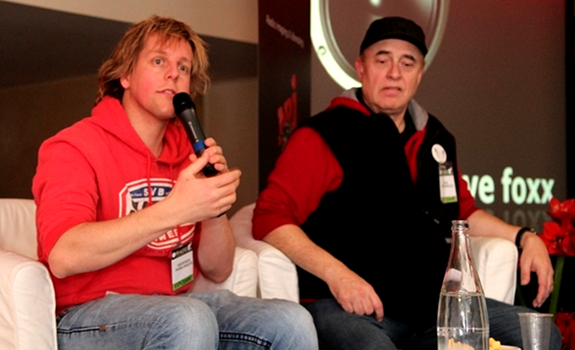
Diederick Huizinga (left) and Dave Foxx (right) talk about radio imaging at Le RADIO 2012 (photo: Serge Surpin)
Compose jingles like hit songs
Diederick Huizinga’s approach when composing and producing station idents with his team, is based on the intention of creating a very short hit song. “A jingle has to be catchy and get your attention“, is one of the 3 key components that he mentions. “Point number two is the quality of the production. All the instruments and drums should sound really good. The third thing is being recognizable. You should instantly know that it’s NRJ or RTL2.”
 Put creative freedom & expression first
Put creative freedom & expression first
However, the most important thing for Diederick is emotion. “Then you really feel passion, and the message gets across.” For this reason, vocal sessions for NRJ station idents and power intros at PURE Jingles are very organic. “The only thing we know before the session is that we should end on ‘NRJ’, and for the rest we give it to the singers.” His vision is that letting talents express themselves is the best way. “Real emotions, that’s what it’s all about.”
Reach radio listeners through emotion
“Emotions are the key”, Dave Foxx agrees. “You cannot win if you try to hit your audience intellectually.” The creative services director of Z100 knows from experience that “going through the mind is not the way to go. If you go through the heart, your message will come through every time and if emotions are the key, music is the key to emotions. Understanding music is one of the fundamentals of being a truly great producer.” It basically comes down to being able to analyze the different parts of music.
“Music is like Lego’s”

WQYK in Tampa, Florida ran a contest where listeners had to build their logo in Lego’s (photo: Flickr, Legohaulic)
10 must-know music editing facts
“Music is like Lego’s. You’ve got notes, measures, tempo, rhythm; all of these parts. The more you know about music, the better off you are. If you become very adept with music components, you can build something that really opens up the heart.” Dave Foxx shared a list of ‘10 things you need to know about music to be an awesome producer’. His promise: “If you know these 10 things and can work with them, your production will improve a 1000 percent”. So check them out below!
 1. Components
1. Components
Music is made up of parts, which can be disassembled and reassembled. “Once you start counting out the music, the editing becomes much simpler, and you can do amazing things. One of our biggest problems at Z100 are so-called cold intros, where the deejay has no chance to say anything, so he either has to talk over the back of another record, or over dead air.” Dave explains how they self-create intros of songs that originally didn’t had one:
[audio:http://www.radioiloveit.com/wp-content/uploads/z100-produced-intro-diddy-dave-foxx-le-radio-2012-paris-france.mp3|titles=Z100 PRODUCED INTRO – Diddy]
2. Tempo
Tempo is always flexible. “Ask any night club DJ and they’ll tell you that some records they have to speed up or slow down to match tempo with whatever song they’re playing.” He adds that about 4-5 percent faster or slower is the maximum before people will start to notice it, and plays a music imaging promo from the Summer of 2011. It’s a nice illustration of how you can build bridges between different tempos:
[audio:http://www.radioiloveit.com/wp-content/uploads/z100-music-image-promo-summertime-dave-foxx-le-radio-2012-paris-france.mp3|titles=Z100 MUSIC IMAGE PROMO – Summertime]
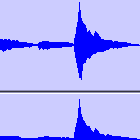 3. Rhythm
3. Rhythm
Rhythm is never flexible. Dave explains that “when you start on a downbeat [or backbeat], make sure that you make the next cut to another downbeat [or backbeat]. It’s got to be on the same place, so the whole thing flows.” Rhythm & flow are an important aspect of successful imaging: “If you try to change the rhythm, people who are dancing will end up on their face.” Here’s an example of a music image promo that you can keep on dancing to:
[audio:http://www.radioiloveit.com/wp-content/uploads/z100-music-image-promo-4th-of-july-dave-foxx-le-radio-2012-paris-france.mp3|titles=Z100 MUSIC IMAGE PROMO – 4th of July]
4. Key
Key is relative. “This is a fun one! When you look at the scale, you’ll see A-B-C-D-E-F-G. Certain pairs sound good together; for example C and E – that’s a third. But if you try to combine C and D, it will sound like a train wreck. So what we do at Z100, is: we step it up” (again building bridges to fill the gap). He plays an example of a format explainer that includes a creative solution to deal with tough transitions:
[audio:http://www.radioiloveit.com/wp-content/uploads/z100-music-image-promo-one-station-all-the-hits-dave-foxx-le-radio-2012-paris-france.mp3|titles=Z100 MUSIC IMAGE PROMO – One Station / All The Hits]
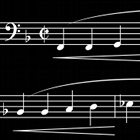 5. Phrasing
5. Phrasing
Musical phrasing is similar to spoken phrasing. “As long as you work with complete phrases, you will always be true to the music and the music will be true to you. That helps with the flow, which is very important. If you’re a rapper, you have to have flow or you die. If you’re an imaging director and you have flow, you’ll not only live; you will rule.” (The audience smiles as Dave is expressing this two-liner with a great sense for diction.)
6. Distortion
Placing voiceover over singing is like two people talking at once. “Don’t ever do that; it’s just wrong!”
 7. Resolution
7. Resolution
Ending the music is like putting a period at the end of a sentence. “Don’t just cut it off; don’t just fade it out – have it come to a natural conclusion; have it resolve.” Z100’s creative services director explains that “if you make the music resolve at the same time that your promo resolves, it’s a great big exclamation point; a big ‘wow!’ at the end of a promo.” He’s using this principle a lot, for example in music image promos like this one:
[audio:http://www.radioiloveit.com/wp-content/uploads/z100-music-image-promo-we-play-all-the-hits-and-so-much-more-dave-foxx-le-radio-2012-paris-france.mp3|titles=Z100 MUSIC IMAGE PROMO – We Play All The Hits / And So Much More]
8. Storytelling
Sung vocals need to support the message. “Clearly, if you’re doing a concert or record sales spot, then you play the hooks whatever they are. But every once in a while you can actually use music hooks to help what you’re promoting.” Dave looks for sung pieces that enhance the voiceover copy, and then combines them so they’ll tell the story together. Like in this promo for a Ke$ha weekend on Z100:
[audio:http://www.radioiloveit.com/wp-content/uploads/z100-contest-promo-kesha-dave-foxx-le-radio-2012-paris-france.mp3|titles=Z100 CONTEST PROMO – Ke$ha]
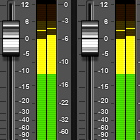 9. Effects
9. Effects
Effects need to support the musical phrasing. “The single biggest mistake I hear in promo after promo after promo, is people who use effects with no music – or music with no effects.” Sounds that are not part of the music, should be functionally used and carefully mixed, so they support the music instead of dominate the promo: “All the little explosions and things like that should be buried in the music, to make it stronger.”
[audio:http://www.radioiloveit.com/wp-content/uploads/z100-music-image-promo-the-biggest-variety-of-hits-dave-foxx-le-radio-2012-paris-france.mp3|titles=Z100 MUSIC IMAGE PROMO – The Biggest Variety Of Hits]
10. Voiceovers
Tracking voiceovers to the music can double its effectiveness. This actually is another proof that music triggers emotions – hearing the music while you talk, gives you an energy boost that can be heard in your voice. Dave doesn’t always do this, but adds that “when I have something that’s very rhythmical – oh my, does it make a difference!” Here’s a Pitbull promo where he tracked his voice over the music:
[audio:http://www.radioiloveit.com/wp-content/uploads/z100-contest-promo-pitbull-dave-foxx-le-radio-2012-paris-france.mp3|titles=Z100 CONTEST PROMO – Pitbull]
“Music can be rather intimidating but actually it’s not”
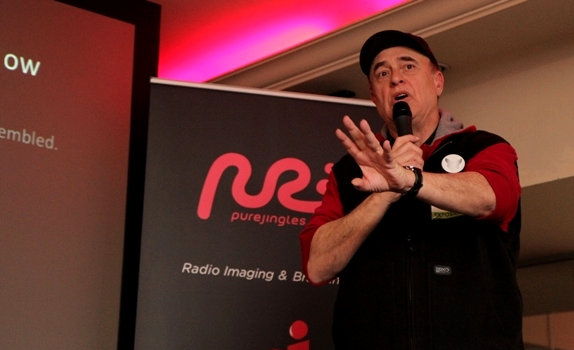
Radio imaging producer Dave Foxx: “The more you know about music, the better off you are” (photo: Serge Surpin)
Learning music theory is useful
Dave Foxx thinks that radio imaging producers should take piano lessons to get a better feeling for music. “I recommend it highly. Six months of piano lessons is all you need.” He personally studied it for over 15 years, but that’s not necessary. “You don’t have to become a master of performance. Only understand the components, so you can build them the way you want. Music can be rather intimidating but actually it’s not, when you see how it’s put together. There are only 4 chords in every hit song ever made.” Dave brought evidence in the form of this brilliant video to end his presentation:
Read also:
Stay tuned, follow us @RadioILOVEIT and click below to share this post:





Add Your Comment